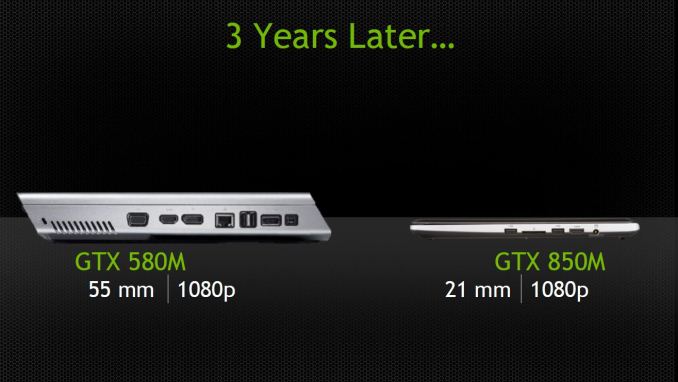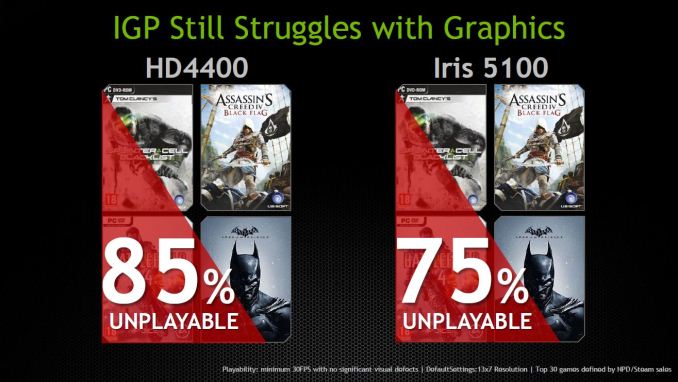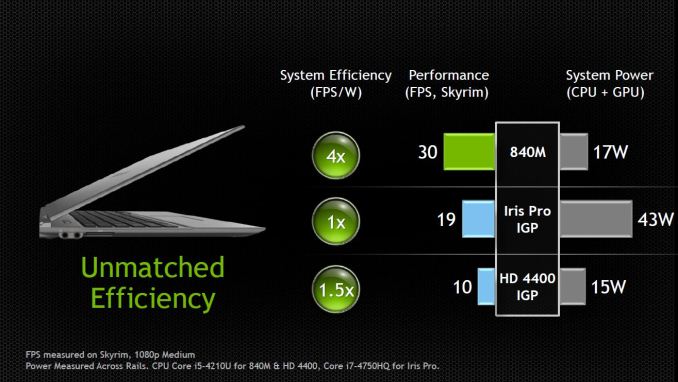NVIDIA’s GeForce 800M Lineup for Laptops and Battery Boost
by Jarred Walton on March 12, 2014 12:00 PM ESTGaming Notebooks Are Thriving
Wrapping things up, I’ll include a gallery of NVIDIA’s slides at the end, but let’s quickly go over a few interesting items. NVIDIA provided some research showing that PC gaming is an extremely large industry – competing in yearly revenue with the likes of movie theater ticket sales, music, and DVD/Blu-ray video sales. Along with that growth, growth in the gaming notebooks market has been significant over the past three years, and even greater growth is expected for 2014. A large part of that is no doubt thanks to Optimus, as it allows potentially any notebook to deliver good gaming performance when you need it while not absolutely killing battery life when you don’t need the GPU. The other aspect is that we are simply seeing more GTX class notebooks shipping, thanks to GPUs like the GTX 760M/765M, and with the 850M now moving into the GTX class (which is where NVIDIA draws the line for “gaming notebooks”) we’ll see even more. But it’s not just about names; the following slide is a great illustration of what we’ve seen since 2011:
It’s not too hard to guess what the notebook on the left is (hello Alienware M17x R3), while on the right it looks like Gigabyte’s P34G. That’s not really important, but the difference in size is pretty incredible, and what’s more, the laptop on the right s actually 30% faster with GTX 850M than the GTX 580M from 2011. It also happens to deliver better battery life – gaming or otherwise. Leaner, lighter, and faster are all good things for gaming notebooks. As you would expect, there are quite a few GTX 800M notebooks coming out soon or in the very near future (while most other 800M parts will mostly come a bit later). NVIDIA provided the following images along with some other information on upcoming laptops, so if you’re in the market keep an eye out for the following (in alphabetical order).
The Alienware 17 will be updated to support both the GTX 870M and GTX 880M. ASUS’ G750JZ will update the G750JH and move from GTX 780M to GTX 880M (and apparently Optimus will be enabled this round). Gigabyte will have new versions of the P34G, the P34R with 860M and the P34J with 850M, an updated P35R (P35K core design) with 860M, and apparently updates to the P25 and P27 as well (likely with mainstream 800M class GPUs, so specifics haven’t been given yet). Lenovo’s Y50 will be their now gaming notebook, with a single GTX 860M and an optional high-DPI display. MSI will also be updating their GT70, GT60, GS70, and GS60; the GT models will support GTX 880M and 870M while the GS models will support the GTX 870M and 860M. And finally (though I suspect we’ll see Clevo, Toshiba, and Samsung announce products with GTX 800M GPUs at some point, along with perhaps some other OEMs as well), Razer Blade will have a new 14” Blade with GTX 870M and a 17” Blade Pro with GTX 860M – and no, that’s not a typo, though perhaps we’ll see more than one model of Blade Pro as it seems odd for the smaller laptop to support a faster GPU.
Finally, on the topic of the need for discrete GPUs in laptops, NVIDIA noted that over 85% of the top 30 games (according to NPD/Steam sales) remain unplayable with Intel’s HD 4400 (no surprise, as that’s basically the same performance as HD 4000), while 75% still remain unplayable with Iris 5100 – this is using 1366x768 resolution with “default settings” (presumably medium, but it’s not specifically stated). What’s missing is information on what’s playable with Iris Pro, but while I can say that most games I’ve tested on Iris Pro are able to break 30FPS average frame rates, ironically power use on the i7-4750HQ laptop I’ve tested is actually worse when gaming than most laptops with GT class 700M GPUs. NVIDIA shows this in their results as well, and while I can’t verify the numbers they claim to provide better performance with a 840M than Iris Pro 5200 while using less than half as much power.
Intel has certainly improved their iGPU performance with the last several processor generations, but unfortunately the higher performance has often come only when given more power – so for example a GT2 or GT3 Haswell part limited to 15W total TDP (i.e. in an Ultrabook) is typically no better than a GT2 Ivy Bridge part with a 17W TDP. Broadwell will likely bring us a “GT4” part (to go along with GT3e), but we’ll have to see if Intel is able to improve performance within the same power envelope when those parts start shipping later this year.

















_thumb.jpg)



















91 Comments
View All Comments
JarredWalton - Thursday, March 13, 2014 - link
I've never been much of a fan of SLI in laptops. Scaling is never perfect, often there is more difficulty with drivers and game compatibility, and battery life can take a hit as well. I mentioned it didn't support SLI, but I can't say it bothers me much. 860M Maxwell supports it (apparently) and will use the same chip, so really it's only going to be a small bump in price to go from two 850M to two 860M -- assuming an OEM wants to do SLI 860M that is.Harmattan - Wednesday, March 12, 2014 - link
I think the thesis of this article is right on: it's a great time for gaming notebooks. The idea just four years ago that I could play the newest games at highest settings at 2560x1600 at more than respectable FPS was unthinkable. My Sager with dual 780ms does that with legs to spare, and I should be able to do this with a SINGLE GPU once high-end Maxwell mobile chips come later this year -- simply amazing.IntelUser2000 - Thursday, March 13, 2014 - link
"we’re talking about a feeble 16GB/s of memory bandwidth – that’s lower than what most desktops and laptops now have for system memory, as DDR3-1600 with a 128-bit interface will do 25.6GB/s."Actually the shared aspect in iGPU systems effectively makes the bandwidth equal to about half that. That is, 12.8GB/s.
JarredWalton - Thursday, March 13, 2014 - link
Only if you're using the iGPU to do something, but since I'm discussing system bandwidth vs. GPU bandwidth I didn't get into that. I suppose something like Kaveri will end up with about the same 16GB/s of bandwidth from the system RAM (with the remaining bandwidth going to the CPU), but really Kaveri will still only be a "moderate" GPU performance level.lmcd - Thursday, March 13, 2014 - link
Since when has Fermi been die shrunk? The 820 needs fact-checked.Ryan Smith - Thursday, March 13, 2014 - link
Since 2012. They released a 28nm version of GF108: GF117.http://www.anandtech.com/show/5697/nvidias-geforce...
jasonelmore - Thursday, March 13, 2014 - link
First Maxwell SLI Enabled GPU!!! and its in a LAPTOP WTFfteoath64 - Thursday, March 13, 2014 - link
Does anybody see why Maxwell part is the starting point and Kepler holding the higher end of the range ?. They are squeezing blood out of Kepler before a complete switch to Maxwell. It is a very clever trick to pull and buys NV time to carefully craft the performance of higher end Maxwell parts to suit the performance/price model they wanted. This release alone seems enough to maintain their discrete gpu market on laptops while AMD struggles with their mobile market. It keeps Intel IGP at bay except for non gamers who do not care about discrete graphics.hero4hire - Thursday, March 13, 2014 - link
I am one of those people that think laptop gaming "is a joke" still. 1hr gaming is still limited but more so is most gamers are going to want to use a mouse not trackpad and therefore use a table. At the point you're gaming at a table why not build a solid desktop and buy an ultraportable for less? Are people unable to spend a 1k to 2k budget better in this regard?I am greatful to see real performance hitting laptops, lower 850m = 580m in the illustration for example. Coming from a purely cost sense I am unconvinced an upgradable desktop and cheap slim low power laptop is not better for the vast majority while also being cheaper. Especially in the long run as you can upgrade a desktop while a $200-$300 laptop won't depreciate like a 1k-2k one will. For example, who is going to buy that 580m laptop for even half its list now? A cheap laptop is almost always worth $100.
lordmocha - Sunday, March 16, 2014 - link
most play plugged into the power and with an external mouseyet the reason to get a gaming laptop (not gaming desktop + laptop) is that it can be cheaper (though performance will be worse), and that it is very portable to take to a friends house